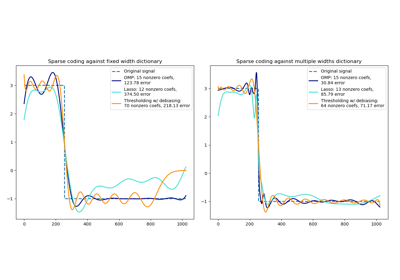W3cubDocs
/scikit-learnsklearn.decomposition.SparseCoder
-
class sklearn.decomposition.SparseCoder(dictionary, transform_algorithm='omp', transform_n_nonzero_coefs=None, transform_alpha=None, split_sign=False, n_jobs=1)[source] -
Sparse coding
Finds a sparse representation of data against a fixed, precomputed dictionary.
Each row of the result is the solution to a sparse coding problem. The goal is to find a sparse array
codesuch that:X ~= code * dictionary
Read more in the User Guide.
Parameters: dictionary : array, [n_components, n_features]
The dictionary atoms used for sparse coding. Lines are assumed to be normalized to unit norm.
transform_algorithm : {‘lasso_lars’, ‘lasso_cd’, ‘lars’, ‘omp’, ‘threshold’}
Algorithm used to transform the data: lars: uses the least angle regression method (linear_model.lars_path) lasso_lars: uses Lars to compute the Lasso solution lasso_cd: uses the coordinate descent method to compute the Lasso solution (linear_model.Lasso). lasso_lars will be faster if the estimated components are sparse. omp: uses orthogonal matching pursuit to estimate the sparse solution threshold: squashes to zero all coefficients less than alpha from the projection
dictionary * X'transform_n_nonzero_coefs : int,
0.1 * n_featuresby defaultNumber of nonzero coefficients to target in each column of the solution. This is only used by
algorithm=’lars’andalgorithm=’omp’and is overridden byalphain theompcase.transform_alpha : float, 1. by default
If
algorithm=’lasso_lars’oralgorithm=’lasso_cd’,alphais the penalty applied to the L1 norm. Ifalgorithm=’threshold’,alphais the absolute value of the threshold below which coefficients will be squashed to zero. Ifalgorithm=’omp’,alphais the tolerance parameter: the value of the reconstruction error targeted. In this case, it overridesn_nonzero_coefs.split_sign : bool, False by default
Whether to split the sparse feature vector into the concatenation of its negative part and its positive part. This can improve the performance of downstream classifiers.
n_jobs : int,
number of parallel jobs to run
Attributes: components_ : array, [n_components, n_features]
The unchanged dictionary atoms
See also
DictionaryLearning,MiniBatchDictionaryLearning,SparsePCA,MiniBatchSparsePCA,sparse_encodeMethods
fit(X[, y])Do nothing and return the estimator unchanged fit_transform(X[, y])Fit to data, then transform it. get_params([deep])Get parameters for this estimator. set_params(**params)Set the parameters of this estimator. transform(X[, y])Encode the data as a sparse combination of the dictionary atoms. -
__init__(dictionary, transform_algorithm='omp', transform_n_nonzero_coefs=None, transform_alpha=None, split_sign=False, n_jobs=1)[source]
-
fit(X, y=None)[source] -
Do nothing and return the estimator unchanged
This method is just there to implement the usual API and hence work in pipelines.
-
fit_transform(X, y=None, **fit_params)[source] -
Fit to data, then transform it.
Fits transformer to X and y with optional parameters fit_params and returns a transformed version of X.
Parameters: X : numpy array of shape [n_samples, n_features]
Training set.
y : numpy array of shape [n_samples]
Target values.
Returns: X_new : numpy array of shape [n_samples, n_features_new]
Transformed array.
-
get_params(deep=True)[source] -
Get parameters for this estimator.
Parameters: deep: boolean, optional :
If True, will return the parameters for this estimator and contained subobjects that are estimators.
Returns: params : mapping of string to any
Parameter names mapped to their values.
-
set_params(**params)[source] -
Set the parameters of this estimator.
The method works on simple estimators as well as on nested objects (such as pipelines). The latter have parameters of the form
<component>__<parameter>so that it’s possible to update each component of a nested object.Returns: self :
-
transform(X, y=None)[source] -
Encode the data as a sparse combination of the dictionary atoms.
Coding method is determined by the object parameter
transform_algorithm.Parameters: X : array of shape (n_samples, n_features)
Test data to be transformed, must have the same number of features as the data used to train the model.
Returns: X_new : array, shape (n_samples, n_components)
Transformed data
-
Examples using sklearn.decomposition.SparseCoder
© 2007–2016 The scikit-learn developers
Licensed under the 3-clause BSD License.
http://scikit-learn.org/stable/modules/generated/sklearn.decomposition.SparseCoder.html
